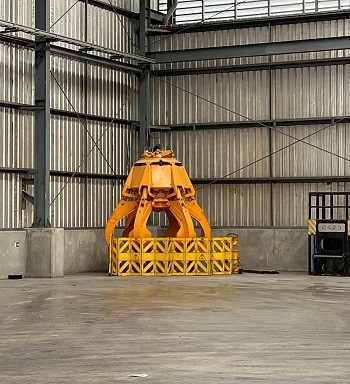Causes and treatment measures for oil leakage and low pressure in grab hydraulic system
Oil leakage causes and treatment measures
Seal problem:
🔍Reason: After long-term use, the seal will age, harden, crack, wear and other phenomena due to high temperature, high pressure, friction and erosion of hydraulic oil, resulting in reduced sealing performance and oil leakage.
✅Handling measures: Check the condition of the seal regularly. Once the seal is found to be aged or damaged, it should be replaced in time with a high-quality seal that meets the system requirements, and ensure that it is installed correctly without distortion or deformation.
Pipe joint problem:
🔍Reason: Vibration and hydraulic shock during equipment operation may cause the pipe joint to loosen, or the pipe joint is not tightened in place during installation, causing oil to leak from the joint.
✅Handling measures: Carefully check all pipe joints and tighten the loose joints with appropriate tools; if the joint is damaged, such as thread stripping, etc., a new pipe joint needs to be replaced.
Oil pipe problem:
🔍Reason: The oil pipe is affected by pressure, wear, corrosion, etc. for a long time, and may be broken, sand eyes, aging and other damage, causing oil leakage.
✅Handling measures: When the oil pipe is found to be damaged, it is necessary to replace it with a new one in time, and check whether the installation position and fixing method of the oil pipe are reasonable to avoid friction or collision between the oil pipe and other components, which may cause further damage.
Hydraulic component failure:
🔍Cause: Damage to the sealing parts of components such as hydraulic cylinders and valves in the hydraulic system can also cause oil leakage. For example, the surface of the piston cylinder is roughened, the upper end cover is improperly installed and the seal is squeezed, or the valve core of the valve is worn and the seal is not tight.
✅Handling measures: Damaged hydraulic components need to be repaired or replaced. When installing new components, pay attention to the operating specifications to ensure installation accuracy and good sealing.
Air mixed in the system:
🔍Cause: When air enters the hydraulic system, it will destroy the continuity of the oil, resulting in unstable oil pressure, high temperature on the high-pressure side, and accelerated aging of the seal. On the low-pressure side, it may cause cavitation, causing damage to the seal, resulting in leakage.
✅Handling measures: Check the air intake parts of the hydraulic system, such as the oil tank, oil pipe joints, etc., to ensure good sealing; exhaust the system by opening the exhaust valve or making the grab move multiple times to exhaust the air from the system.
Causes and treatment measures for low pressure
Insufficient oil in the tank:
🔍Reason: Insufficient hydraulic oil will make the hydraulic system unable to build up enough pressure, resulting in insufficient power for the grab.
✅Handling measures: Check the oil level of the hydraulic oil tank regularly. When the oil level is lower than the specified value, add the required hydraulic oil to the normal oil level in time.
Overflow valve failure:
🔍Reason: The opening pressure of the overflow valve is too low, the main valve core and the cone valve core are worn too much, the seal is damaged, the spring is broken or the damping hole is blocked, etc., which will cause the system pressure to fail to reach the normal working pressure.
✅Handling measures: Disassemble the overflow valve, check the condition of the valve core, spring, seal and other components, and replace the damaged parts; clean the impurities in the damping hole to ensure the normal operation of the overflow valve.
Hydraulic pump failure:
🔍Reason: Wear and blockage of the hydraulic pump, the transmission key falls off, the inlet and outlet are connected in reverse, the speed is too low, etc., which will affect the output flow and pressure of the hydraulic oil, thereby reducing the pressure of the grab hydraulic system.
✅Handling measures: Check the working condition of the hydraulic pump, repair or replace the seriously worn parts; ensure that the transmission key is firmly installed and the inlet and outlet are connected correctly; adjust the speed of the hydraulic pump to the appropriate range.
Hydraulic pipeline blockage:
🔍Cause: Impurities, oil stains and other blockages in the pipeline will hinder the flow of hydraulic oil, resulting in pressure loss and lower system pressure.
✅Handling measures: Clean the hydraulic pipeline, and use special cleaning agents and tools for flushing; check and replace the blocked filter to ensure that the pipeline is unobstructed and the oil can flow normally.
Hydraulic cylinder leakage:
🔍Cause: Wear or damage of the piston seal, wear-resistant ring and other parts inside the hydraulic cylinder will cause leakage in the hydraulic cylinder, resulting in lower system pressure.
✅Handling measures: Replace the seals and worn parts of the hydraulic cylinder, repair or replace the damaged hydraulic cylinder to restore its normal sealing performance and working capacity.
Oil contamination:
🔍Cause: Impurities, moisture or gas mixed in the hydraulic oil will affect the performance and fluidity of the hydraulic oil, resulting in a drop in the pressure of the hydraulic system, and may also accelerate the wear of the seals and cause oil leakage.
✅Handling measures: Regularly replace the hydraulic oil and clean the system filter to ensure the cleanliness of the hydraulic oil; when adding hydraulic oil, ensure the quality and cleanliness of the oil to prevent contaminants from entering the system.





